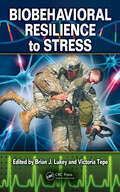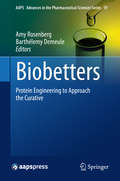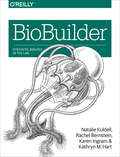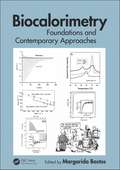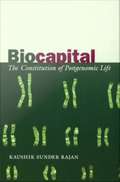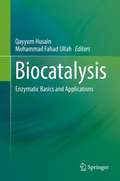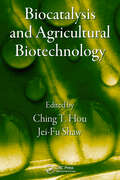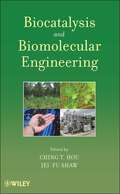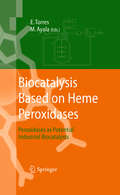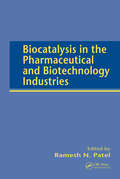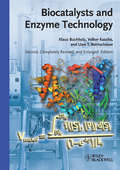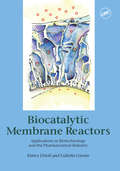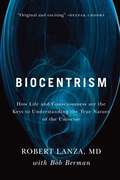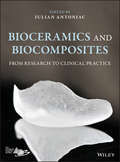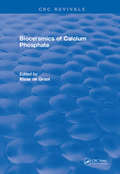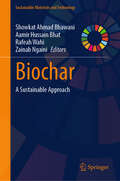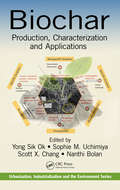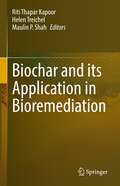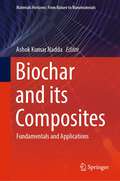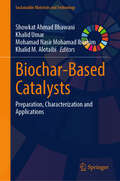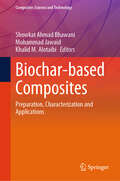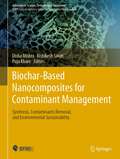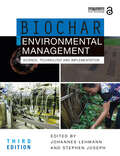- Table View
- List View
Biobehavioral Resilience to Stress
by Brian J. Lukey Victoria TepeMilitary service involves exposure to multiple sources of chronic, acute, and potentially traumatic stress, especially during deployment and combat. Notoriously variable, the effects of stress can be subtle to severe, immediate or delayed, impairing individual and group readiness, operational performance, and ultimately‘survival. A comprehensive co
Biobetters: Protein Engineering to Approach the Curative (AAPS Advances in the Pharmaceutical Sciences Series #19)
by Amy Rosenberg Barthélemy Demeule"Biobetters: Protein Engineering to Approach the Curative" discusses the optimization of protein therapeutic products for treatment of human diseases. It is based on the fact that though numerous important therapeutic protein products have been developed for life threatening and chronic diseases that possess acceptable safety and efficacy profiles, these products have generally not been reexamined and modified for an improved clinical performance, with enhancements both to safety and efficacy profiles. Advances in protein engineering, coupled with greatly enhanced understanding of critical product quality attributes for efficacy and safety, make it possible to optimize predecessor products for clinical performance, thereby enhancing patient quality of life and with the potential for great savings in health care costs. Yet despite such knowledge, there is little movement towards such modifications. This book examines engineering protein therapeutic products such that they exhibit an optimal, not just an adequate, clinical performance profile. Two product classes, therapeutic enzymes for lysosomal storage diseases (enzyme replacement therapies, ERT) and monoclonal antibodies (mAbs), are used as examples of what modifications to such proteins could be made to enhance clinical performance, "closer to a cure" as it were. For ERT, the key to optimizing clinical performance is to ensure the ERT is endowed with moieties that target the protein to the relevant target tissue. Thus, for Gaucher Disease, our best example of how to optimize an ERT to address a disease that manifests in specific target tissues (macrophages and monocytes), the enzyme has been extensively modified to target macrophages. For diseases such as Pompe Disease, largely a disorder of muscle, optimal performance of ERT will depend on endowing the enzyme with the ability to be taken up via the Mannose 6 Phosphate Receptor, and so one of the chapters in the book will discuss such approaches. Moreover, a major failure of biotechnology based products is to gain access to the CNS, a key target tissue in numerous diseases. Thus, a chapter has been devoted to strategies to access the CNS. Additionally, immune responses to therapeutic proteins can be highly problematic, eliminating the efficacy of life saving or highly effective protein therapeutics. This is especially poignant in the case of Pompe Disease wherein great improvement in muscle strength and functionality is lost following development of an immune response to the ERT with consequent patient deterioration and death. Thus, a chapter regarding protein engineering, as well as other non-clinical approaches to diminishing immunogenicity is a valuable part of the book. Monoclonal antibodies (mAbs) can be engineered to bind targets relevant to a wide variety of diseases; binding affinity, however, is only part of the equation and one of the chapters will present a molecular assessment approach that balances affinity with pharmacokinetics and manufacturability. As with other proteins immunogenicity can be problematic, being responsible for loss of efficacy of anti-TNF mAbs, often after prolonged successful treatment. The authors will also share their perspective on the consequences of physico-chemical modifications occurring to mAbs once they reach the circulation or their target, a research area open to further development from a protein engineering as well as analytical perspective. This book will also discuss novel platforms for protein therapeutics, technologies that exceed mAbs with respect to potency, and hence, potentially efficacy. These platforms consist largely of repeat domain proteins with very high affinity for their target ligands, but while potentially more efficacious, immunogenicity may be a major problem limiting use. The economics surrounding the issue of biobetters is another high-profile issue - this final chapter will explore the incentives and disincentives for developing biobetters and consider incentives that might make their pursuit more rewarding.
BioBuilder: Synthetic Biology in the Lab
by Natalie Kuldell Rachel Bernstein Karen Ingram Kathryn M HartToday’s synthetic biologists are in the early stages of engineering living cells to help treat diseases, sense toxic compounds in the environment, and produce valuable drugs. With this manual, you can be part of it. Based on the BioBuilder curriculum, this valuable book provides open-access, modular, hands-on lessons in synthetic biology for secondary and post-secondary classrooms and laboratories. It also serves as an introduction to the field for science and engineering enthusiasts.Developed at MIT in collaboration with award-winning high school teachers, BioBuilder teaches the foundational ideas of the emerging synthetic biology field, as well as key aspects of biological engineering that researchers are exploring in labs throughout the world. These lessons will empower teachers and students to explore and be part of solving persistent real-world challenges.Learn the fundamentals of biodesign and DNA engineeringExplore important ethical issues raised by examples of synthetic biologyInvestigate the BioBuilder labs that probe the design-build-test cycleTest synthetic living systems designed and built by engineersMeasure several variants of an enzyme-generating genetic circuitModel "bacterial photography" that changes a strain’s light sensitivityBuild living systems to produce purple or green pigmentOptimize baker’s yeast to produce ?-carotene
Biocalorimetry: Foundations and Contemporary Approaches
by Margarida BastosConnecting past, present, and future instrument development and use, Biocalorimetry: Foundations and Contemporary Approaches explores biocalorimetry's history, fundamentals, methodologies, and applications. Some of the most prominent calorimeter developers and users share invaluable personal accounts of discovery, discussing innovative techniques a
Biocapital: The Constitution of Postgenomic Life
by Kaushik Sunder RajanBiocapital is a major theoretical contribution to science studies and political economy. Grounding his analysis in a multi-sited ethnography of genomic research and drug development marketplaces in the United States and India, Kaushik Sunder Rajan argues that contemporary biotechnologies such as genomics can only be understood in relation to the economic markets within which they emerge. Sunder Rajan conducted fieldwork in biotechnology labs and in small start-up companies in the United States (mostly in the San Francisco Bay area) and India (mainly in New Delhi, Hyderabad, and Bombay) over a five-year period spanning 1999 to 2004. He draws on his research with scientists, entrepreneurs, venture capitalists, and policymakers to compare drug development in the two countries, examining the practices and goals of research, the financing mechanisms, the relevant government regulations, and the hype and marketing surrounding promising new technologies. In the process, he illuminates the global flow of ideas, information, capital, and people connected to biotech initiatives. Sunder Rajan's ethnography informs his theoretically sophisticated inquiry into how the contemporary world is shaped by the marriage of biotechnology and market forces, by what he calls technoscientific capitalism. Bringing Marxian theories of value into conversation with Foucaultian notions of biopolitics, he traces how the life sciences came to be significant producers of both economic and epistemic value in the late twentieth century and early twenty-first.
Biocatalysis: Enzymatic Basics and Applications
by Mohammad Fahad Ullah Qayyum HusainThis book introduces readers to industrially important enzymes and discusses in detail their structures and functions, as well as their manifold applications. Due to their selective biocatalytic capabilities, enzymes are used in a broad range of industries and processes. The book highlights selected enzymes and their applications in agriculture, food processing and discoloration, as well as their role in biomedicine. In turn, it discusses biochemical engineering strategies such as enzyme immobilization, metabolic engineering, and cross-linkage of enzyme aggregates, and critically weighs their pros and cons. Offering a wealth of information, and stimulating further research by presenting new concepts on enzymatic catalytic functions in basic and applied contexts, the book represents a valuable asset for researchers from academia and industry who are engaged in biochemical engineering, microbiology and biotechnology.
Biocatalysis and Agricultural Biotechnology
by Ching T. Hou Jei-Fu ShawWorldwide energy and food crises are spotlighting the importance of bio-based products - an area many are calling on for solutions to these shortages. Biocatalysis and Agricultural Biotechnology encapsulates the cutting-edge advances in the field with contributions from more than 50 international experts comprising sectors of academia, industry, an
Biocatalysis and Biomolecular Engineering
by Ching T. Hou Jei-Fu ShawAn expert overview of new technologies guiding the construction of a sustainable society This compendium of important insights from sixty distinguished international scholars looks at the significant advances in progressive environmental technology—especially the molecular engineering used on plants, animals, and microorganisms—as the game changer in the high-stakes race to reverse earth-damaging practices. Biocatalysis and Biomolecular Engineering covers subject matter on the latest developments in eco-friendly and energy-saving manufacturing processes with the emphasis on agricultural technology and bio-based products. Focusing its study on remedies that show promise in curing food and energy ills, this book examines groundbreaking work in various fields, such as nutraceuticals, genetic engineering of agricultural products, and bioenergy. Biocatalysis and Biomolecular Engineering: Can be used as a reference by teachers, graduate students, and industrial scientists who conduct research in bioscience and biotechnology Serves as the first book to bring together fundamentals and leading-edge technologies for the development of bio-based industrial products through biocatalysis; for example, it discusses the preparation of biofunctional micro- and nanoparticles Contains chapters by international experts from academia, industry, and government research institutes Biocatalysis and Biomolecular Engineering builds a cohesive, well thought out case for nurturing new discoveries in eco-technology by inviting critical discussion on devising viable solutions to sustaining the future wellness of humankind.
Biocatalysis Based on Heme Peroxidases: Peroxidases as Potential Industrial Biocatalysts
by Eduardo Torres Marcela AyalaThis monograph describes many applications of peroxidase-based biocatalysis in the biotechnology industry. The need for such a book emerges from the considerable amount of new data regarding the phylogeny, reaction mechanisms, thermodynamic characterization and structural features of fungal and plant heme peroxidases that has been generated in the past 10 years, since the last specialized book on peroxidases was published. The aim of this book is to present recent advances on such basic aspects as evolution, structure-function relation and catalytic mechanism as well as applied aspects, such as bioreactor and protein engineering, to provide the tools for rational design of enhanced biocatalysts and biocatalytic processes.
Biocatalysis for Practitioners: Techniques, Reactions and Applications
by Gonzalo De Gonzalo Iván LavanderaThis reference book originates from the interdisciplinary research cooperation between academia and industry. In three distinct parts, latest results from basic research on stable enzymes are explained and brought into context with possible industrial applications. Downstream processing technology as well as biocatalytic and biotechnological production processes from global players display the enormous potential of biocatalysts. Application of "extreme" reaction conditions (i.e. unconventional, such as high temperature, pressure, and pH value) - biocatalysts are normally used within a well defined process window - leads to novel synthetic effects. Both novel enzyme systems and the synthetic routes in which they can be applied are made accessible to the reader. In addition, the complementary innovative process technology under unconventional conditions is highlighted by latest examples from biotech industry.
Biocatalysis in the Pharmaceutical and Biotechnology Industries
by Ramesh N. PatelBecause enzyme-catalyzed reactions exhibit higher enantioselectivity, regioselectivity, substrate specificity, and stability, they require mild conditions to react while prompting higher reaction efficiency and product yields. Biocatalysis in the Pharmaceutical and Biotechnology Industries examines the use of catalysts to produce fine chemic
Biocatalysts and Enzyme Technology
by Klaus Buchholz Volker Kasche Uwe Theo BornscheuerThis second edition of a bestselling textbook offers an instructive and comprehensive overview of our current knowledge of biocatalysis and enzyme technology. The book now contains about 40% more printed content. Three chapters are completely new, while the others have been thoroughly updated, and a section with problems and solutions as well as new case studies have been added. Following an introduction to the history of enzyme applications, the text goes on to cover in depth enzyme mechanisms and kinetics, production, recovery, characterization and design by protein engineering. The authors treat a broad range of applications of soluble and immobilized biocatalysts, including wholecell systems, the use of non-aqueous reaction systems, applications in organic synthesis, bioreactor design and reaction engineering. Methods to estimate the sustainability, important internet resources and their evaluation, and legislation concerning the use of biocatalysts are also covered.
Biocatalytic Membrane Reactors: Applications In Biotechnology And The Pharmaceutical Industry
by Enrico Drioli Lidietta GiornoThis research level reference book has been co-written by Enrico Drioli, perhaps one of the world's best known researchers into membrane technology. The application of membrane technology to chemical transformation and molecular separation are beginning to be exploited in the pharmaceutical science and biotechnology industries, but there is a need for researchers and students to have up-to-date literature - and this book provides it. The book will be of interest to students of chemistry, chemical engineering, pharmacy and biotechnology.
Biocentrism: How Life and Consciousness are the Keys to Understanding the True Nature of the Universe
by Robert Lanza Bob BermanRobert Lanza is one of the most respected scientists in the world — a US News & World Report cover story called him a &“genius" and a &“renegade thinker," even likening him to Einstein. Lanza has teamed with Bob Berman, the most widely read astronomer in the world, to produce Biocentrism, a revolutionary new view of the universe. Every now and then a simple yet radical idea shakes the very foundations of knowledge. The startling discovery that the world was not flat challenged and ultimately changed the way people perceived themselves and their relationship with the world. For most humans of the 15th century, the notion of Earth as ball of rock was nonsense. The whole of Western, natural philosophy is undergoing a sea change again, increasingly being forced upon us by the experimental findings of quantum theory, and at the same time, towards doubt and uncertainty in the physical explanations of the universe's genesis and structure. Biocentrism completes this shift in worldview, turning the planet upside down again with the revolutionary view that life creates the universe instead of the other way around. In this paradigm, life is not an accidental byproduct of the laws of physics. Biocetnrism takes the reader on a seemingly improbable but ultimately inescapable journey through a foreign universe—our own—from the viewpoints of an acclaimed biologist and a leading astronomer. Switching perspective from physics to biology unlocks the cages in which Western science has unwittingly managed to confine itself. Biocentrism will shatter the reader's ideas of life--time and space, and even death. At the same time it will release us from the dull worldview of life being merely the activity of an admixture of carbon and a few other elements; it suggests the exhilarating possibility that life is fundamentally immortal. The 21st century is predicted to be the Century of Biology, a shift from the previous century dominated by physics. It seems fitting, then, to begin the century by turning the universe outside-in and unifying the foundations of science with a simple idea discovered by one of the leading life-scientists of our age. Biocentrism awakens in readers a new sense of possibility, and is full of so many shocking new perspectives that the reader will never see reality the same way again.
Bioceramics and Biocomposites: From Research to Clinical Practice
by Iulian AntoniacProvides comprehensive coverage of the research into and clinical uses of bioceramics and biocomposites Developments related to bioceramics and biocomposites appear to be one the most dynamic areas in the field of biomaterials, with multiple applications in tissue engineering and medical devices. This book covers the basic science and engineering of bioceramics and biocomposites for applications in dentistry and orthopedics, as well as the state-of-the-art aspects of biofabrication techniques, tissue engineering, remodeling, and regeneration of bone tissue. It also provides insight into the use of bionanomaterials to create new functionalities when interfaced with biological molecules or structures. Featuring contributions from leading experts in the field, Bioceramics and Biocomposites: From Research to Use in Clinical Practice offers complete coverage of everything from extending the concept of hemopoietic and stromal niches, to the evolution of bioceramic-based scaffolds. It looks at perspectives on and trends in bioceramics in endodontics, and discusses the influence of newer biomaterials use on the structuring of the clinician’s attitude in dental practice or in orthopedic surgery. The book also covers such topics as biofabrication techniques for bioceramics and biocomposites; glass ceramics: calcium phosphate coatings; brain drug delivery bone substitutes; and much more. Presents the biggest trends in bioceramics and biocomposites relating to medical devices and tissue engineering products Systematically presents new information about bioceramics and biocomposites, developing diagnostics and improving treatments and their influence on the clinicians' approaches Describes how to use these biomaterials to create new functionalities when interfaced with biological molecules or structures Offers a range of applications in clinical practice, including bone tissue engineering, remodeling, and regeneration Delineates essential requirements for resorbable bioceramics Discusses clinical results obtained in dental and orthopedic applications Bioceramics and Biocomposites: From Research to Use in Clinical Practice is an excellent resource for biomaterials scientists and engineers, bioengineers, materials scientists, and engineers. It will also benefit mechanical engineers and biochemists who work with biomaterials scientists.
Bioceramics Calcium Phosphate
by K. de GrootThe first chapters are fundamental, in that the physical chemistry of calcium phosphate salts is discussed, along with mineralization (with emphasis on teeth) and remodelling of mineralized tissues. Thereafter follows a treatment of the influence of implants o surrounding hard tissues. This topic is followed by a chapter on preparation methods and biomechanical and biological aspects of calcium phosphate implants. In conclusion, two chapters are devoted to (possible) dental and medical applications. It is hoped that basic researchers can use the book in their efforts to improve this promising class of materials further, and that clinicians are inspired to define further possibilities and � at least as important � limitations.
Biochar: A Sustainable Approach (Sustainable Materials and Technology)
by Showkat Ahmad Bhawani Aamir Hussain Bhat Rafeah Wahi Zainab NgainiThis book highlights the latest research on biochar, a low-cost carbonaceous material produced from biomass, and is regarded as an economical substitute to the activated carbon. The book describes the production and the characteristics of biochar through various techniques/methods such as pyrolysis, gasification, torrefaction, and hydrothermal carbonization of carbonaceous biomass, such as agricultural residues, algal biomass, forest residues, manures, activated sludge, energy crops, digestate at high temperature (300–900 °C) and under O2-limiting conditions. The book also highlights the several unique properties of biochar such as an efficient, cost-effective, and environmentally-friendly material for diverse contaminants removal. The variability in physicochemical properties (e.g., surface area, micro-porosity, and pH) provides an avenue for biochar to maximize its efficacy to targeted applications. This book interests academics working in the development of green and sustainable technology in agricultural engineering, material science, chemical engineering, and environmental science.
Biochar: Production, Characterization, and Applications (Urbanization, Industrialization, and the Environment)
by Yong Sik Ok Sophie M. Uchimiya Scott X. Chang Nanthi BolanEncompassing high priority research areas such as bioenergy production, global warming mitigation, and sustainable agriculture, biochar has received increased worldwide interest in the past decade.Biochar: Production, Characterization, and Applications covers the fundamentals of biochar including its concept, production technology, and characteriza
Biochar and its Application in Bioremediation
by Helen Treichel Maulin P. Shah Riti Thapar KapoorBiochar prepared from agricultural biomass has received considerable attention because of the huge availability of ago-waste at zero cost, flexibility, high efficiency, renewability, faster contaminant removal rate, ability to treat concentrated effluent and reduction of sludge production after the treatment. This book on biochar is a comprehensive account of preparation of biochar from agricultural waste. It provides a roadmap in development of future strategy for pollution abatement and sustainable waste management. This book contains up-to-date information on biochar and its role in environment protection. The book covers useful information and applications of biochar to research scholars, academicians, agronomists, scientists and environmentalist working in the field of environment protection, bioremediation, waste management and climate change mitigation.
Biochar and its Composites: Fundamentals and Applications (Materials Horizons: From Nature to Nanomaterials)
by Ashok Kumar NaddaThe book discusses the commercial applications of biochar and its composites. Biochar prepared from pyrolysis of waste biomass is gaining widespread attention in environmental remediation due to its multifaceted benefits. This book explores these possible applications of biochar in water treatment and removal of pollutants from the contaminated sites. It also emphasizes the role of biochar engineering through different physical and chemical methods to enhance structural and physicochemical properties of biochar such as surface area, porosity and surface functional group. It also focuses on the diverse source of biomass that can be used for biochar production, different methodologies for biochar preparation and biochar engineering for improvement of its properties. Finally, it describes all the applications of biochar that can contribute to environmental remediation and sustainability. Given the contents, the book will be useful for students, researchers and professionals in the area of environmental chemistry and material science.
Biochar Applications in Agriculture and Environment Management
by Jay Shankar Singh Chhatarpal SinghThis book provides up-to-date information on biochar use in management of soil health, agriculture productivity, green-house gases, restoration ecology and environment. Biochar application to nutrient deficient and disturbed soils is a viable option which may promotes advances in food safety and food security to human nutrition and overall fundamental research in the agricultural sciences. The book describes in detail how the recalcitrant biochar is able to persist for long periods of time and work as a shelter for soil microbial colonisation and their biomass/numbers. This book also includes contents related to important role of biochar applications in the restoration of contaminated agricultural soils. The book will be of particular interest to students, teachers and researchers in the disciplines.
Biochar-Based Catalysts: Preparation, Characterization and Applications (Sustainable Materials and Technology)
by Showkat Ahmad Bhawani Khalid Umar Mohamad Nasir Mohamad Ibrahim Khalid M. AlotaibiThis book reviews comprehensively the field and development of biochar-based catalyst by summarizing fundamental approaches and principles to prepare biochar and biochar-based catalysts and focusing on the main applications of biochar-based catalysts in environmental remediation. Biochar is a low-cost carbonaceous material produced from biomass and is regarded as an economical substitute to the activated carbon. The coverage of book highlights the most exciting applications of biochar-based catalysts in different reactions such as oxidation, reduction, hydrolysis, isomerization, dehydration, etc. The book is useful for the academics and researchers who are interested in the development biochar-based catalysts with background in material science, chemical engineering, environmental engineering and environmental chemistry.
Biochar-based Composites: Preparation, Characterization and Applications (Composites Science and Technology)
by Showkat Ahmad Bhawani Mohammad Jawaid Khalid M. AlotaibiThis book provides solid, quantitative descriptions and reliable guidelines, reflecting the maturation and demand of the field and the development of biochar-based composites. This book summarizes the fundamental approaches and principles to prepare biochar-based composites. This book focuses on some important materials (metal oxide/hydroxide, magnetic, clay minerals, graphene oxide, etc.) used for the production of the composites. The coverage of book highlights the most exciting applications of biochar-based composites in the removal of organic and inorganic contaminants from waste water. The book is useful for the academics and researchers who are interested in the development biochar-based composites with background in material science, chemical engineering, environmental engineering and environmental chemistry.
Biochar-Based Nanocomposites for Contaminant Management: Synthesis, Contaminants Removal, and Environmental Sustainability (Advances in Science, Technology & Innovation)
by Disha Mishra Rishikesh Singh Puja KhareThis book helps the readers get a holistic understanding of the emergence of biochar-nanocomposite research. The low and long-term exposure of persistent hazardous pollutants in environment is well known for damaging the water, soil, sediments, and living biota. Thus, it is a crucial step to eliminate these pollutants from environment regimes to prevent the on-site destruction or the transfer into the food chain. Biochar is a carbon-rich solid material generated through pyrolysis of biomass, and currently, it is covering the hotspot in environmental management of pollutants. It is being utilized for the efficient immobilization and sorption of organic pollutants, heavy metals, dyes, improvement of soil redox conditions, aggregate stabilization, photocatalytic degradation, and for carbon sequestration. The fascinating properties like surface area, porous structures, functional groups, and mineral components turn it into suitable candidate for the removal of various class of pollutants from environmental matrices. Different reactions like sorption, reduction, precipitation, solidification, and degradation are mainly responsible for the effective cleaning of xenobiotics from environment through biochar application. However, rapidly evolving contaminants in the environment have made the remediation more complex, expensive, and challenging. In view of these aspects, the modification of biochar through the doping of nanometals/metal oxides/surfactants/ or chemical entities will result in modified biochar with high surface area, more functional entities, improved physical, chemical, thermal, and mechanical characteristics with more adsorptive sites. Inclusion of these exclusive properties can be done through magnetic modification, impregnation of nanometals/ metal oxides/surfactants, amination, acid/base reactions, steam activation, etc. The resulted biochar-based nanocomposites have demonstrated a vital role in remediation of persistent organic pollutants, radionuclei, and heavy metals through the various interaction mechanisms like surface complexation, π–π interaction, electrostatic interaction, hydrogen bonding, Fenton process, and photocatalytic degradation. Currently, advanced research work has been carried out for the designing of modified composites of biochar to achieve maximum removal efficiency, reusability, biotoxicity, and sustainability. Hence, for selective removal of pollutants through designed biochar surface with the focused experimentation toward optimization of feedstocks, process variables, appropriate impregnation of nanomaterials, interaction with secondary pollutants, physical environment, longevity, and regeneration will definitely pave the way for safe and commercial application of biochar-based nanocomposites.
Biochar for Environmental Management: Science, Technology and Implementation
by Stephen JosephFully revised and updated for its third edition, this book presents the definitive compilation of current knowledge on all aspects of biochar.Research on biochar continues to accelerate as its importance for soil health, climate change mitigation and adoption, and the circular economy becomes more widely acknowledged. This book not only reviews recent advances made in our understanding of biochar properties, behavior, and effects in agriculture, environmental management, and material production, but specifically develops fundamental principles and frameworks of biochar science and application. This third edition has been fully revised and updated to reflect recent developments and growing trends, with important coverage of the application of biochar outside of its traditional soil-based uses, the commercialization of biochar, and its incorporation into policy. This includes brand new chapters on the role of biochar-based materials for environmental remediation, building construction, and animal feed, and a greater discussion of biochar's role in the circular economy, climate change mitigation, and sustainable development. Overall, this book provides a systematic, comprehensive, and global examination of biochar. Written by an international team of academics and professionals, it addresses its uses, production, and management and its broader potential for mitigating climate change and driving forward sustainable development.Edited by two leading figures in the field, Biochar for Environmental Management is essential reading for students, scholars, practitioners, and policymakers interested in biochar and the role it can play in environmental sustainability and global sustainable development.Chapter 16 of this book is freely available as a downloadable Open Access PDF at http://www.taylorfrancis.com under a Creative Commons Attribution-Non Commercial-No Derivatives (CC-BY-NC-ND) 4.0 license.
